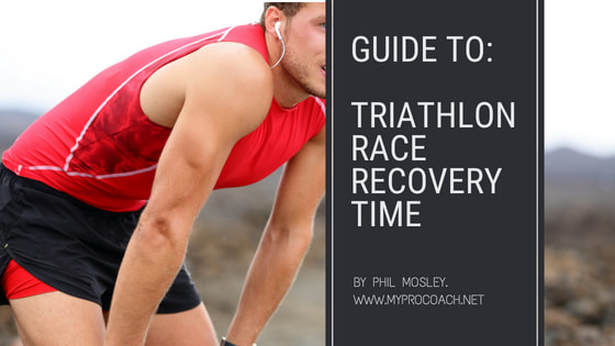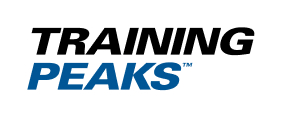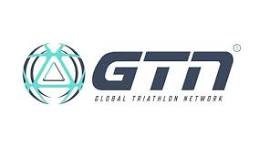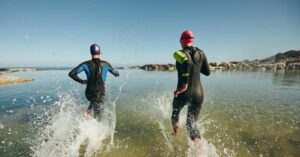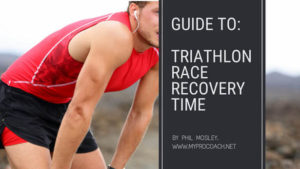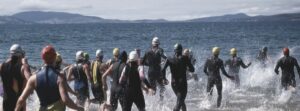How much time between races do you need? This guide explains how to recover, train and race, when you have multiple events.
If you love triathlons, duathlons, running and cycling, it can be very tempting to enter lots of events during the race season.
However, every event you do takes a certain amount of time to recover from. And if you enter too many, too close together, you won’t give your body a chance to recuperate. Meaning you’ll go from one race to the next, feeling stale, sore and tired.
In this blog, I want to show you how long it takes to recover after an endurance event such as a triathlon. And I’ll give you some tips on how to recover and train between your races.
Recovery between events depends on three things:
1. The length of the race
2. Your fitness and race experience
3. How effectively you paced yourself on race day
Let’s talk about each of these three factors individually:
1. The length of the race
The shorter the race, the quicker you’ll recover afterwards. So if you race a short race such as a sprint distance triathlon you might recover in a week.
Whereas if you race an IRONMAN 140.6, you might expect a longer recovery period such as a month.
You’ll experience the most tiredness in the first 48 hours after your race, so there is no benefit to training during this period while your muscles are sore and your body is tired. The best recovery straight after a race is total rest.
After the first 48 hours (or more) of acute fatigue, you’ll start to feel more normal. But not quite fresh enough to resume full-blown training. During this phase, you’ll experience a less intense, but longer-lasting kind of fatigue. And it’s better to train at a low intensity until you’re fully recovered. This helps you stay fit AND recover from your race. If you train too hard during this phase you’ll only increase your recovery time.
Recovery From A Sprint Distance Triathlon (or 10k)
Or any endurance event that’s 1-hour 40 or less.
Typical Recovery Time: 7 to 10 days.
- After your race, take 48 hours off to allow for full recovery.
- For the remainder of the week train in Zone 2 (Easy or Steady). All workouts should be less than 1 hour.
- Include further recovery days if you need to during this period.
- Once you feel fully recovered (typically 7-10 days) resume your normal training.
Recovery From An Olympic Distance Triathlon (or Half Marathon)
Or any endurance event that’s 1 hour 40 to 3-hours in duration.
Typical Recovery Time: 10 to 14 days.
- After your race, take 48-72 hours off to allow for full recovery.
- Then train in Zone 2 only (Easy or Steady) for up to two weeks.
- Include further recovery days if you need to during this period.
- During the recovery period, all swims should be 60 mins or less.
- During the recovery period, all run workouts should be 40 mins or less.
- During the recovery period all bike workouts less than 2 hours.
- Once you feel fully recovered (typically 2 weeks but often sooner) resume your normal training.
Recovery From An Ironman 70.3 Triathlon (or Marathon)
Or any endurance event that’s between 4 and 7-hours
Typical Recovery Time: 14 to 28 days.
- After your race, take 48-96 hours as complete rest
- For the next 10-24 days train in Zone 2 only (Easy or Steady).
- Include further recovery days if you need to during this period.
- During the recovery period, all swims should be 60 mins or less.
- During the recovery period, all run workouts should be 60 mins or less
- During the recovery period all bike workouts less than 2 hours 30.
- Once you feel fully recovered (typically 2-4 weeks) resume your normal training.
Recovery From An Ironman 140.6 Triathlon (or Ultra Marathon)
Or any endurance event that’s between 8 and 17-hours
Typical Recovery Time: 21 days plus.
- After your race, take one entire week as complete rest
- After this, train in Zone 2 only (Easy or Steady) for another 14 to 30 days.
- Include further recovery days if you need to during this period.
- During the recovery period, all swims should be 60 mins or less.
- During the recovery period, all run workouts should be 40 mins or less.
- During the recovery period all bike workouts less than 2 hours.
- Don’t rush your recovery – for some people it can take up to 3 months to feel 100% (physically and mentally) after an Ironman 140.6 triathlon.
2. Why fitness and experience count
If you’ve read the advice above, you’ll now have some idea of how long it takes to recover from your event. It’s also worth remembering that these time-frames rely partly on your fitness and experience.
For example, a professional triathlete might race at their best for three consecutive weekends in a row. Whereas an experienced amateur might need a two-week gap between races to perform well. And a beginner might need a four-week gap to recover and get race-ready again.
It’s important to consider your own level when you’re planning your season or setting race goals.
3. How pacing affects race recovery times
If you want to recover quickly from a triathlon (or similar endurance event), you need to pace yourself sensibly on race day. That doesn’t mean doing a slower time. It simply means pacing your effort evenly throughout rather than going too hard in the first half of the race. This usually leads to faster race times.
Pacing is not such a major factor when recovering from a sprint-distance triathlon. Chances are you’ll recover in 7-10 days regardless.
However, pacing is a moderate-sized deal in an Olympic triathlon. And a BIG DEAL for Ironman 70.3 or Ironman 140.6 events.
If you pace yourself optimally on race day, you will a) Race Faster and b) Recover Quicker.
Whereas if you race too hard, your legs will eventually get sore, which will impede your ability to continue cycling and running fast. Racing too hard also impedes your body’s ability to digest things like energy drinks and energy gels. So it’s a double whammy of bad news – sore legs AND a belly full of energy drinks and gels all sloshing around, not being digested.
You should treat each discipline of triathlon as part of a bigger race. So if an Olympic distance triathlon takes you around 3 hours, you need to swim, bike and run like you’re in a 3-hour race. Not like you’re in three separate short races.
For more information about pacing read my blog post about pacing an Ironman 70,3 race. And my three separate blogs about pacing an Ironman 140.6 swim, bike and run.
When the rules don’t apply
Some endurance events are tougher than others, which means you can’t apply the same recovery rules across the board. For instance, an 8-hour run will take you longer to recover from than an 8-hour cycle, because it’s weight-bearing and you’ll have more muscle damage. Similarly, an 8-hour triathlon will take longer to get over, compared to an 8-hour cycle, because there’s more running involved. In fact, recovery from cycling and swimming events can be much quicker than those that involve running. But this depends on your own personal experience and fitness level.
Other factors that influence your recovery times include the heat and humidity on the event day, how you fuel yourself before, during and after. Also, whether you have the right-gearing on your bike for any hilly terrain. Struggling up big climbs in too-big gears will cause extra muscle damage and increase your recovery time.
